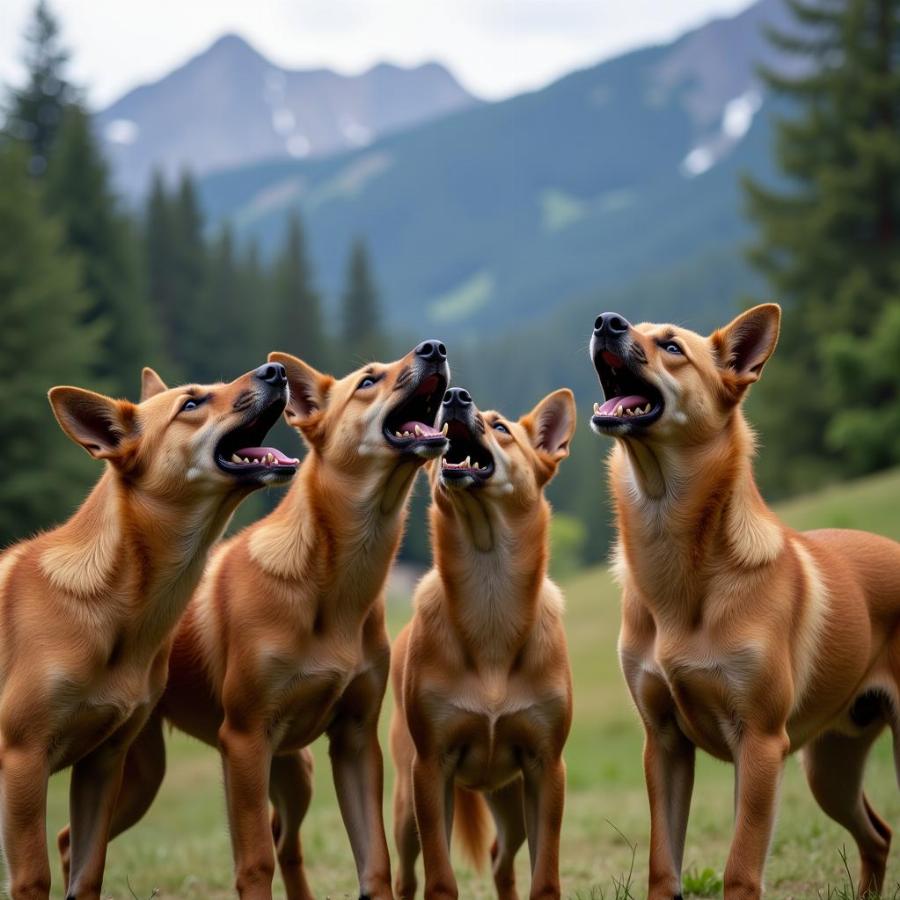The unique and enchanting sound of the New Guinea singing dog is a captivating topic for dog enthusiasts. If you’ve ever wondered about the new guinea singing dog sound, you’ve come to the right place. This article delves into the fascinating vocalizations of these rare and primitive canids, exploring the science behind their howls, the reasons they sing, and what makes their voices so distinctive.
Deciphering the New Guinea Singing Dog’s Vocalizations
The New Guinea singing dog, known for its wild and primitive nature, possesses an extraordinary vocal range unlike any other canine. Their name, derived from their characteristic “singing” howls, hints at the complex and melodious nature of their communication. These aren’t your typical dog barks or howls. They are a series of rising and falling notes, often harmonizing with other dogs, creating a chorus that echoes through their native habitat. This unique vocalization is a crucial aspect of their social behavior, allowing them to communicate across vast distances in the dense forests of New Guinea.
Why Do New Guinea Singing Dogs Sing?
The new guinea singing dog sound serves several purposes. Like other canids, these dogs use their howls to maintain contact with their pack, especially in dense vegetation where visual contact is limited. Their complex vocalizations also play a role in territorial defense, warning off intruders and establishing boundaries. Furthermore, the “singing” may strengthen social bonds within the pack, much like group singing does in human cultures. It’s a fascinating example of the sophisticated communication methods employed by these remarkable animals.
The Science Behind the Song: How They Produce Their Unique Sound
The unique harmonic richness of the new guinea singing dog sound stems from the structure of their larynx. While research is ongoing, it’s believed that specific anatomical features contribute to the extended range and harmonic complexity of their vocalizations. These dogs can produce a wider range of frequencies than most other canids, allowing for the characteristic rising and falling notes that resemble singing. Their howls can be described as haunting, melodic, and unlike any other dog breed.
 Pack of New Guinea Singing Dogs Howling
Pack of New Guinea Singing Dogs Howling
Comparing the New Guinea Singing Dog Sound to Other Canids
While all canids use vocalizations to communicate, the new guinea singing dog sound is truly unique. Compared to the typical barks and howls of domestic dogs or wolves, the New Guinea singing dog’s vocalization is far more complex and melodious. It incorporates a wider range of frequencies and harmonic overtones, giving it a distinct musical quality. This difference highlights the primitive nature of the breed and its close connection to its wild ancestors.
What does a New Guinea singing dog sound like?
The New Guinea singing dog’s vocalization is a series of rising and falling notes, often described as yodeling or howling. They can produce a surprisingly wide range of frequencies, creating a unique and memorable sound.
How often do New Guinea singing dogs sing?
The frequency of singing varies depending on the situation and the individual dog. They may sing more frequently during territorial disputes, when separated from their pack, or during social interactions.
Are there any recordings of the New Guinea singing dog sound?
Yes, numerous recordings of the new guinea singing dog sound are available online and in scientific research databases. Listening to these recordings is the best way to appreciate the unique vocal qualities of this rare breed.
Conservation Efforts and the Future of the New Guinea Singing Dog Sound
The New Guinea singing dog is considered endangered in the wild, making conservation efforts crucial. Protecting their habitat and supporting breeding programs are vital to preserving not only the dogs themselves but also their unique vocalizations. The new guinea singing dog sound is a testament to the biodiversity of our planet, and its loss would be a tragedy.
Conclusion
The new guinea singing dog sound is a captivating phenomenon that showcases the complexity of animal communication. From the science behind their unique vocalizations to the crucial role these sounds play in their survival, the New Guinea singing dog offers a glimpse into the fascinating world of wild canids. By understanding and appreciating these remarkable animals, we can contribute to their conservation and ensure that their enchanting songs continue to echo through the forests for generations to come.
FAQ
- What makes the New Guinea singing dog’s howl unique? Their howl is unique due to the complex range of frequencies and harmonics they can produce, creating a melodic, almost musical sound.
- Is the New Guinea singing dog related to the dingo? While the exact relationship is debated, they share some genetic similarities and are both considered primitive canids.
- Are New Guinea singing dogs good pets? Due to their wild nature and specialized needs, they are generally not recommended as pets for the average person.
- Where can I hear a New Guinea singing dog howl? Recordings are readily available online and through research databases.
- Are New Guinea singing dogs endangered? Yes, they are considered endangered in the wild.
You Might Also Be Interested In:
(No related articles found on Beaut Dogs at this time.)
Beaut Dogs: Your Ultimate Guide to Canine Companions
Beaut Dogs is your trusted source for everything related to canine companions. We offer expert advice on dog breeds, care, training, and much more. From understanding the unique new guinea singing dog sound to choosing the perfect breed for your lifestyle, https://beautdogs.com has you covered. When you need support, contact us at [email protected] (Email address) to get detailed and accurate answers from Beaut Dogs.